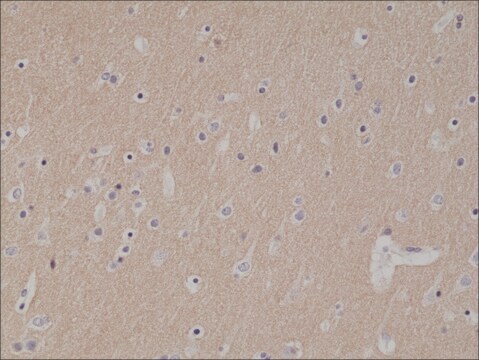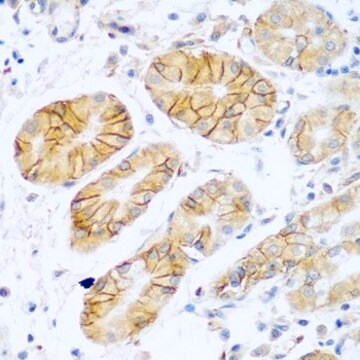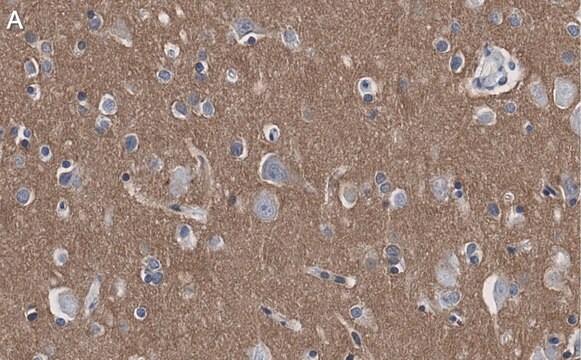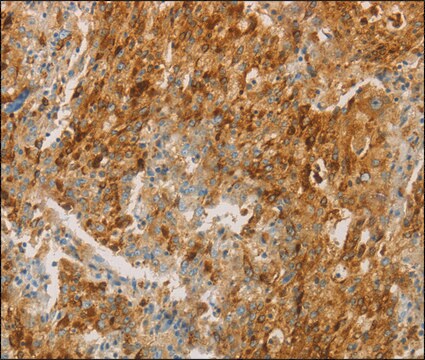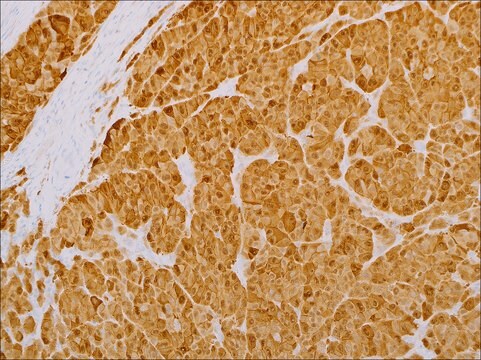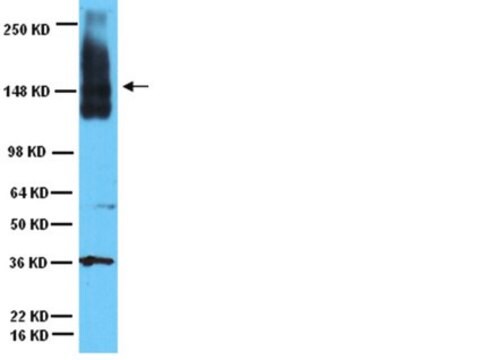おすすめの製品
由来生物
mouse
品質水準
100
500
結合体
unconjugated
抗体製品の状態
culture supernatant
抗体製品タイプ
primary antibodies
クローン
123C3.D5, monoclonal
詳細
For In Vitro Diagnostic Use in Select Regions (See Chart)
フォーム
buffered aqueous solution
交差性
human
包装
vial of 0.1 mL concentrate (156M-84)
vial of 0.5 mL concentrate (156M-85)
bottle of 1.0 mL predilute (156M-87)
vial of 1.0 mL concentrate (156M-86)
bottle of 7.0 mL predilute (156M-88)
メーカー/製品名
Cell Marque®
テクニック
immunohistochemistry (formalin-fixed, paraffin-embedded sections): 1:100-1:500
アイソタイプ
IgG1κ
コントロール
neuroblastoma
輸送温度
wet ice
保管温度
2-8°C
視覚化
membranous
遺伝子情報
human ... NCAM1(4684)
詳細
Anti-CD56 recognizes two proteins of the neural cell adhesion molecule, the basic molecule expressed on most neuroectodermally derived cell lines, tissues and neoplasms (e.g. retinoblastoma, medulloblastomas, astrocytomas, neuroblastomas, and small cell carcinomas). It is also expressed on some mesodermally derived tumors (rhabdomyosarcoma).
関連事項
CD56 Positive Control Slides, Product No. 156S, are available for immunohistochemistry (formalin-fixed, paraffin-embedded sections).
物理的形状
Solution in Tris Buffer, pH 7.3-7.7, with 1% BSA and <0.1% Sodium Azide
調製ノート
Download the IFU specific to your product lot and formatNote: This requires a keycode which can be found on your packaging or product label.
その他情報
For Technical Service please contact: 800-665-7284 or email: service@cellmarque.com
法的情報
Cell Marque is a registered trademark of Merck KGaA, Darmstadt, Germany
適切な製品が見つかりませんか。
製品選択ツール.をお試しください
最新バージョンのいずれかを選択してください:
試験成績書(COA)
Lot/Batch Number
R Gerardy-Schahn et al.
International journal of cancer. Supplement = Journal international du cancer. Supplement, 8, 38-42 (1994-01-01)
Monoclonal antibodies (MAbs) ranked together as small-cell-lung-cancer (SCLC) Cluster I MAbs are directed against the neural cell adhesion molecule NCAM (CD 56) and have been shown to be useful reagents in SCLC diagnosis and therapy. We analyzed the epitopes recognized
C E Moolenaar et al.
Cancer research, 50(4), 1102-1106 (1990-02-15)
Monoclonal antibodies (MAbs) 123C3 and 123A8 generated against a membrane preparation of a small cell lung carcinoma (SCLC) specimen recognize not only SCLC and bronchial carcinoids but also a significant portion of non-small cell lung carcinomas (non-SCLC) of various histological
R E Kibbelaar et al.
European journal of cancer (Oxford, England : 1990), 27(4), 431-435 (1991-01-01)
We investigated the expression of the neural cell adhesion molecule (NCAM) in a series of surgically resected lung carcinomas of various histological subtypes by means of a panel of monoclonal antibodies recognising different N-CAM epitopes. In a subgroup of 56
Scott A Ely et al.
The American journal of pathology, 160(4), 1293-1299 (2002-04-12)
Unlike monoclonal gammopathy of undetermined significance (MGUS) or non-Hodgkin's lymphomas (NHLs) with plasmacytoid differentiation, multiple myeloma (MM) is commonly associated with lytic bone lesions. Although the mechanisms of increased osteoclast activity are partially understood, comparatively little is known about the
Masahiko Sumi et al.
Leukemia & lymphoma, 44(1), 201-204 (2003-04-15)
We present a case of duodenal non-Hodgkin lymphoma in a 71-year-old woman. Immunohistochemistry characterized the lymphoma cells as CD2(+); surface CD3(-) but cytoplasmic CD3(+); CD7(+); and CD56(+) without a rearrangement of the T-cell receptor gene. Cells had a high N/C
ライフサイエンス、有機合成、材料科学、クロマトグラフィー、分析など、あらゆる分野の研究に経験のあるメンバーがおります。.
製品に関するお問い合わせはこちら(テクニカルサービス)